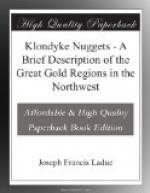“About a mile below Rink Rapids the river spreads out into a lake-like expanse, with many islands; this continues for about three miles, when it contracts to something like the usual width; but bars and small islands are very numerous all the way to Pelly River. About five miles above Pelly River there is another lake-like expanse filled with islands. The river here for three or four miles is nearly a mile wide, and so numerous and close are the islands that it is impossible to tell when floating among them where the shores of the river are. The current, too, is swift, leading one to suppose the water shallow; but I think even here a channel deep enough for such boats as will navigate this part of the river can be found. Schwatka named this group of islands “Ingersoll Islands.”
“At the mouth of the Pelly the Lewes is about half a mile wide, and here too there are many islands, but not in groups as at Ingersoll Islands.
“About a mile below the Pelly, just at the ruins of Fort Selkirk, the Yukon was found to be 565 yards wide; about two-thirds being ten feet deep, with a current of about four and three-quarter miles per hour; the remaining third was more than half taken up by a bar, and the current between it and the south shore was very slack.
“Pelly River at its mouth is about two hundred yards wide, and continues this width as far up as could be seen. Dr. Dawson made a survey and examination of this river, which will be found in his report already cited, “Yukon District and Northern British Columbia.”
“Just here for a short distance the course of the Yukon is nearly west, and on the south side, about a mile below the mouth of the Lewes, stands all that remains of the only trading post ever built by white men in the district. This post was established by Robert Campbell, for the Hudson’s Bay Company in the summer of 1848. It was first built on the point of land between the two rivers, but this location proving untenable on account of flooding by ice jams in the spring, it was, in the season of 1852, moved across the river to where the ruins now stand. It appears that the houses composing the post were not finished when the Indians from the coast on Chilkat and Chilkoot Inlets came down the river to put a stop to the competitive trade which Mr. Campbell had inaugurated, and which they found to seriously interfere with their profits. Their method of trade appears to have been then pretty much as it is now—very onesided. What they found it convenient to take by force they took, and what it was convenient to pay for at their own price they paid for.
“Rumors had reached the post that the coast Indians contemplated such a raid, and in consequence the native Indians in the vicinity remained about nearly all summer. Unfortunately, they went away for a short time, and during their absence the coast Indians arrived in the early morning, and surprised Mr. Campbell in bed. They were not at all rough with him, but gave him the privilege of leaving the place within twenty-four hours, after which he was informed that he was liable to be shot if seen by them in the locality. They then pillaged the place and set fire to it, leaving nothing but the remains of the two chimneys which are still standing. This raid and capture took place on the 1st August, 1852.




